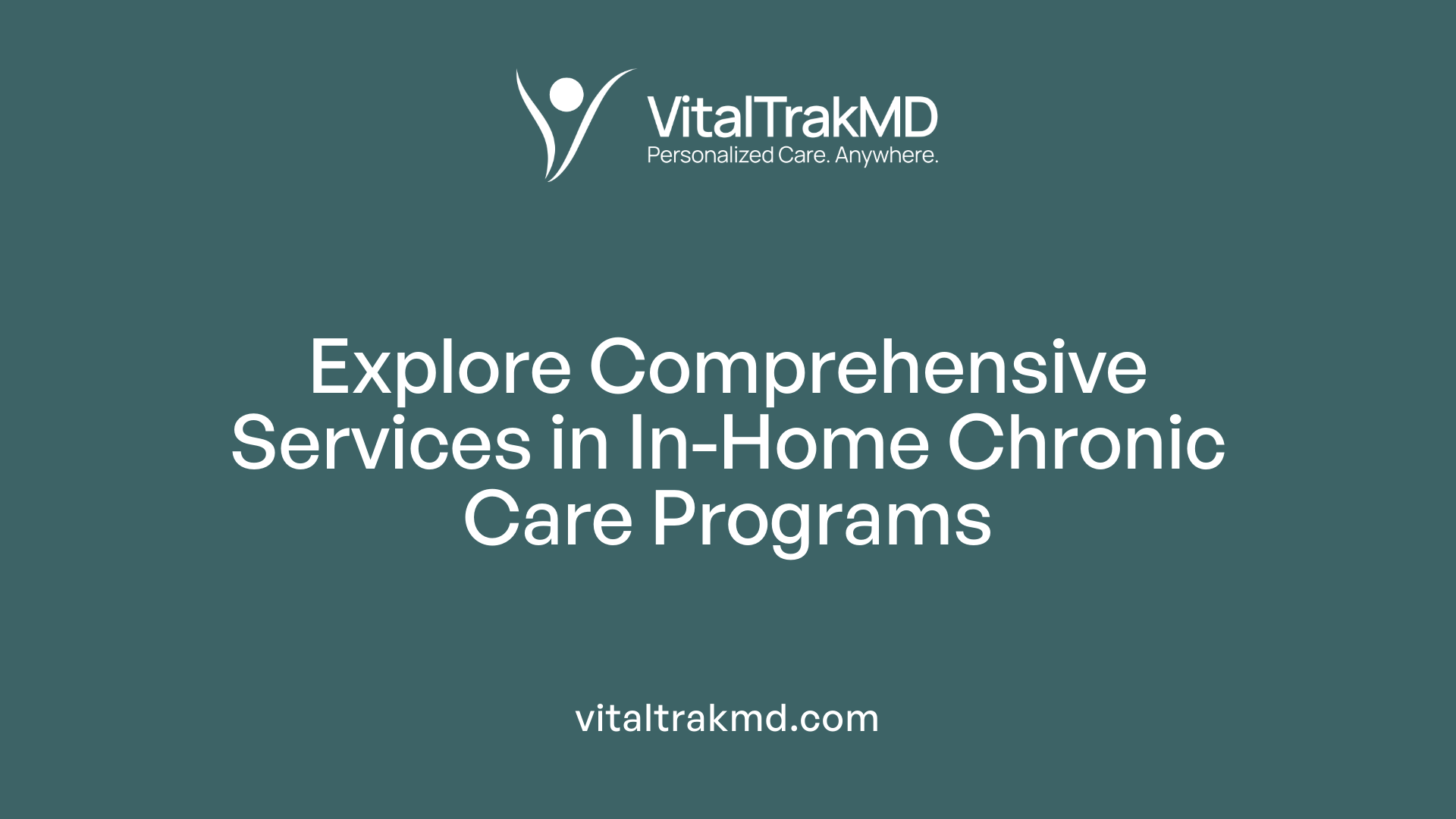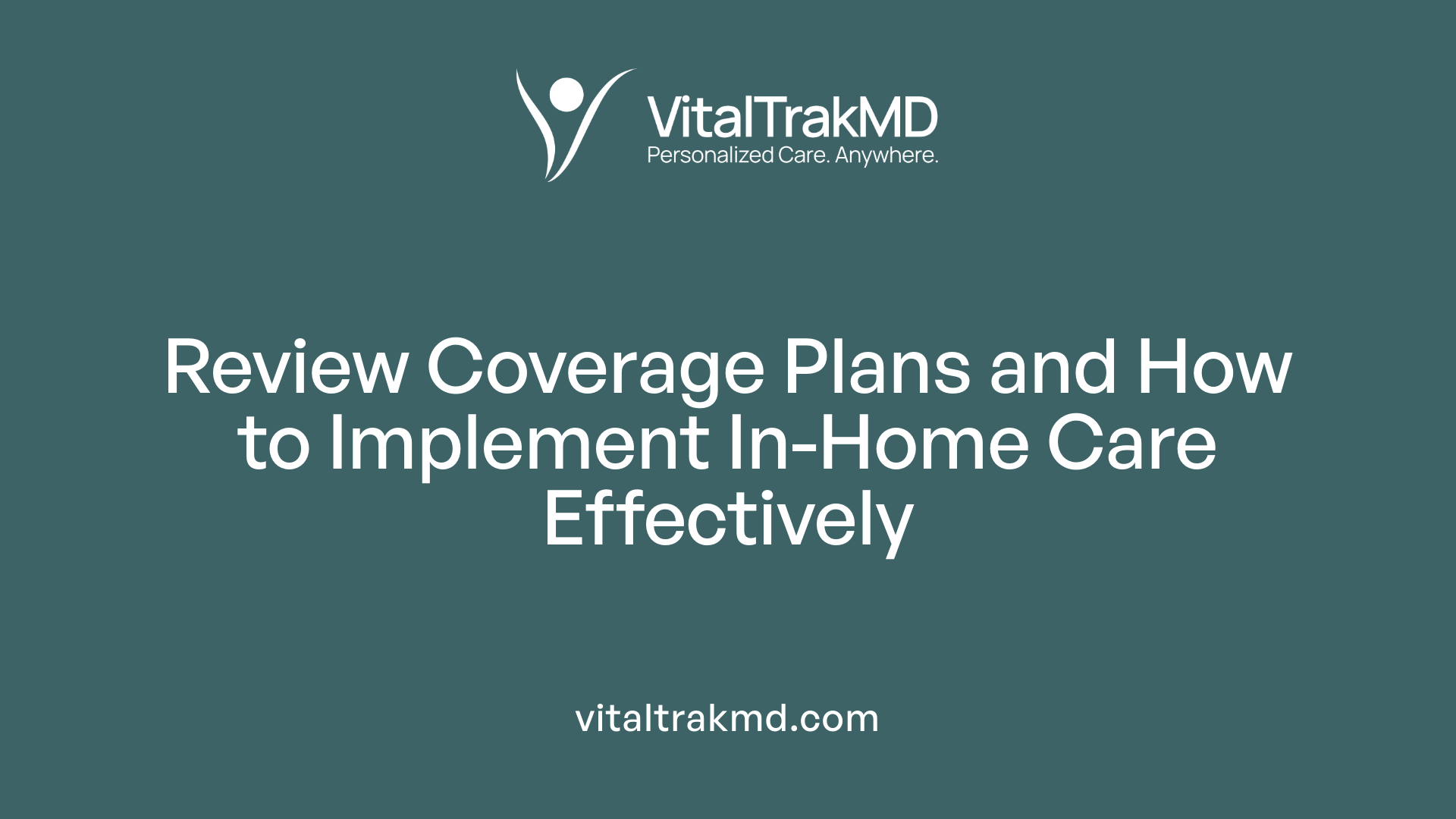In-Home Chronic Care Plans Available

A New Era of Chronic Condition Management at Home
As healthcare evolves towards personalized and value-based models, in-home chronic care plans have emerged as a crucial strategy to enhance health outcomes, improve quality of life, and reduce costs for individuals living with long-term conditions. These programs leverage advanced care coordination, remote monitoring, and multidisciplinary collaboration, offering a comprehensive approach to managing chronic diseases within the familiar comfort of home. This article explores the core features, benefits, eligibility criteria, scope of services, coverage options, implementation processes, and resources associated with in-home chronic care plans, emphasizing their growing availability across communities in the Eastern United States.
Understanding In-Home Chronic Care Plans and Their Core Features

What are in-home chronic care plans and their core features?
In-home chronic care plans are tailored health strategies aimed at helping individuals manage long-lasting health conditions from the comfort of their home. These plans are designed to engage patients actively in their care, fostering independence and better health outcomes.
A central component of these plans is the development of a comprehensive, person-centered approach. This involves creating a detailed care plan that addresses the patient's specific needs, including medication management, lifestyle advice, symptom tracking, and setting health goals that align with the patient’s values and priorities. The care plan serves as a roadmap, guiding medical treatments and daily activities.
Collaboration among the patient, family caregivers, and a multidisciplinary healthcare team is crucial. This team often includes doctors, nurses, pharmacists, social workers, and therapists, all working together to ensure cohesive care delivery. Effective communication tools such as electronic health records (EHRs) facilitate real-time information sharing among team members, enhancing coordination, reducing errors, and ensuring that everyone is updated about the patient’s condition.
Remote monitoring technologies play a significant role in managing chronic conditions at home. These devices track vital signs like blood pressure, glucose levels, heart rate, and physical activity, transmitting the data electronically to healthcare providers. This ongoing surveillance allows for early detection of issues, enabling prompt intervention before complications develop.
A hallmark of modern in-home care is the availability of 24/7 access to healthcare professionals. Whether through hotlines, telehealth platforms, or direct communication channels, patients can receive urgent advice, ask questions, or seek assistance at any time. This continuous access reduces hospital admissions, improves safety, and reassures patients throughout their health journey.
Education and self-management support are equally vital. Patients are empowered with knowledge about their conditions, understanding symptoms to watch for and ways to manage them effectively. Educational resources cover medication adherence, healthy lifestyle choices, and understanding warning signs that require medical attention.
In summary, in-home chronic care plans combine personalized, coordinated healthcare strategies, advanced monitoring technologies, and ongoing professional support. They aim to stabilize health conditions, minimize hospital visits, improve quality of life, and foster autonomous, well-informed patients prepared to manage their health proactively.
Advantages and Benefits of In-Home Chronic Care Management

What are the benefits and advantages of in-home chronic care management?
In-home chronic care management (CCM) offers a range of significant benefits that enhance both the quality of care and the patient experience. One of the primary advantages is the increased convenience it provides to patients. Receiving care in the comfort of their own home eliminates the need for frequent trips to healthcare facilities, which can be especially difficult for those with mobility issues, disabilities, or multiple chronic conditions.
Personalized treatment is another crucial aspect. In-home CCM allows healthcare providers to tailor care plans specific to each individual’s medical history, lifestyle, and personal preferences. This personalized approach improves the relevance and effectiveness of care, leading to better health outcomes.
Research consistently shows that in-home CCM can reduce hospitalizations, emergency room visits, and overall mortality rates among chronic disease patients. By monitoring health status closely and intervening early, providers can prevent complications before they require more intensive and costly treatments.
The continuous nature of in-home care also fosters stronger relationships between patients and healthcare teams. This ongoing interaction helps build trust and open communication, which are essential for effective self-management and adherence to treatment protocols.
Care coordination is more efficient when services are delivered at home. Providers can observe real-time living conditions and social circumstances, facilitating more timely and appropriate interventions. Such coordination ensures that all aspects of a patient's health—medical, psychological, and social—are addressed holistically.
Cost-effectiveness is a further benefit. By reducing hospital admissions and unnecessary emergency visits, in-home CCM can lower healthcare costs on a systemic level. This aligns with value-based healthcare models that prioritize outcomes and efficiency.
Overall, in-home chronic care management not only supports better health outcomes but also enhances the quality of life for individuals managing long-term conditions. It is a patient-centered approach that emphasizes comfort, personalization, and continuous support, making it an invaluable strategy for modern healthcare systems.
More Info Search Query: Benefits of In-Home Chronic Disease Management, Patient-Centered Care Models,
Services Included in In-Home Chronic Care Opportunities

What services are typically included in in-home chronic care programs?
In-home chronic care programs are designed to provide comprehensive support for individuals managing long-term health conditions. These services aim to improve health outcomes, enhance quality of life, and prevent complications through tailored, patient-centered care.
A core component of these programs is skilled nursing care. This includes performing medical assessments to monitor the patient's health status, managing medications to ensure proper adherence, and wound care for chronic or acute injuries. Nurses and other healthcare professionals often visit the home or provide services via telehealth, offering education and ongoing health management.
Therapeutic services are another vital element. Physical therapy helps maintain or regain mobility and strength, occupational therapy supports daily living activities, and speech therapy assists with communication challenges or swallowing difficulties. These therapies are tailored to the patient's needs and are aimed at improving everyday functioning.
Nutrition plays a major role in managing many chronic conditions. Nutritional counseling helps patients develop healthy eating habits, optimize medication effects, and manage disease-specific dietary restrictions.
Mental health support is also integral, with social workers or mental health professionals providing counseling to address emotional well-being, reduce stress, and support coping strategies. Addressing mental health is essential for holistic care and improving overall health outcomes.
Care coordination ensures that all healthcare providers—doctors, specialists, therapists, and pharmacists—work in sync. This involves regular communication and updates to develop and adjust personalized care plans, facilitate medication management, and schedule necessary visits or tests.
Support for daily activities, medication adherence, and symptom monitoring are emphasized to help patients manage their conditions independently. Providers assist with chores, personal care tasks such as bathing and dressing, and monitor for any symptom changes or exacerbations that require prompt attention.
Finally, health empowerment and self-management programs educate patients on managing their conditions effectively. These programs encourage adherence to treatment plans, promote healthy behaviors, and foster independence, thereby reducing hospital readmissions and improving overall health stability.
Through this comprehensive approach, in-home chronic care programs not only deliver necessary medical services but also support the emotional, nutritional, and daily living needs of individuals, empowering them to lead healthier and more manageable lives.
Functionality, Scope, and How These Plans Operate
How do in-home chronic care plans work and what is their scope?
In-home chronic care plans, such as those offered through Medicare’s Chronic Care Management (CCM) program, focus on a comprehensive, coordinated approach to managing patients with multiple or complex chronic conditions directly in their homes or local community environments.
These plans gather health information through initial assessments and ongoing monitoring to understand each patient's unique needs. Following a detailed face-to-face evaluation with a healthcare provider, a personalized, all-encompassing care plan is created. This plan is aimed at stabilizing health, preventing complications, and promoting independence.
The scope of services includes activities like routine care management, health education to empower patients, medication management to ensure safety and adherence, symptom monitoring, and connecting patients with community resources. These services extend beyond simple visits, emphasizing continuous support through remote interactions such as phone calls and digital communication, as well as in-person visits when needed.
A multidisciplinary team often manages these programs, comprising physicians, nurse practitioners, pharmacists, social workers, dietitians, therapists, and community health workers. This team works collaboratively to deliver seamless care tailored to each individual's health status and lifestyle.
Ongoing assessment is a vital component, involving regular reviews of health status, updating care plans, and adjusting treatments as necessary. Patients are supported in self-management—learning how to handle their conditions, navigate the healthcare system, and make healthier lifestyle choices.
The ultimate goal of these plans is to improve overall health outcomes, reduce emergency visits, hospital admissions, and healthcare costs. They aim to keep individuals healthier longer, maintain functional independence, and enhance quality of life in community settings.
Eligibility Criteria for In-Home Chronic Care Access

Who is eligible for in-home chronic care plans?
Access to in-home chronic care services generally hinges on a patient's health conditions and specific requirements established by healthcare providers and insurance policies. The primary eligibility criterion is having at least two chronic conditions that are expected to persist for a minimum of 12 months. These conditions must pose a significant risk of worsening, leading to functional decline, hospitalization, or even death.
Diseases and health issues that qualify include, but are not limited to, diabetes, hypertension, chronic heart failure, arthritis, chronic obstructive pulmonary disease (COPD), mental health disorders, cancer, and autoimmune diseases. The aim is to support patients with complex or long-term health needs through personalized, continuous care.
For Medicare beneficiaries, additional criteria include being classified as "homebound," which means leaving home is either extremely difficult or requires considerable effort. Such individuals often need skilled nursing, therapy, or other medical services that cannot be provided in a non-home setting.
Before initiating these services, patients are usually required to undergo a face-to-face evaluation with a healthcare provider, who assesses their medical needs, validates eligibility, and develops a comprehensive care plan. Consent from the patient or their representative is also necessary, ensuring they understand and agree to the proposed care arrangements.
Furthermore, insurance plans like Medicaid may also provide similar services through specialized programs called Health Homes. These programs target individuals with multiple or serious health conditions and sometimes include those at risk of developing additional health problems, thus offering a broader safety net.
In summary, eligibility for in-home chronic care programs is determined based on the presence of multiple persistent conditions, functional status, and specific medical and logistical needs that necessitate ongoing, coordinated medical attention at home.
| Criteria | Conditions & Requirements | Additional Notes |
|---|---|---|
| Medical Conditions | Diabetes, Hypertension, Heart Disease, Arthritis, COPD, Cancer, etc. | Must be expected to last at least 12 months or until death |
| Functional Status | Homebound status | Significant difficulty leaving home |
| Provider Evaluation | Face-to-face assessment required | Conducted by a licensed healthcare professional |
| Consent | Informed written consent needed | Ensures patient understanding of care plan |
| Insurance & Coverage | Medicare, Medicaid, private insurance plans | Coverage varies; Medicare has specific guidelines |
| Additional Programs | Medicaid Health Homes, specialized SNPs | Suitable for complex health needs and multiple conditions |
For those considering in-home care services, it’s advisable to contact healthcare providers or insurance representatives to verify eligibility based on individual health circumstances and ensure all required assessments and consents are completed for seamless access.
Coverage Options and Implementation Strategies

What coverage options are available for long-term in-home care under Medicare and other health plans?
Long-term in-home care coverage varies widely based on the type of insurance and the individual’s specific needs. Medicare primarily provides coverage for certain home health services, but only under specific conditions. It covers skilled nursing care, physical therapy, occupational therapy, speech-language pathology, social services, and home health aide care, but these must be part of a plan for a temporary or rehabilitative need, with patients generally required to be homebound and in need of intermittent skilled care.
However, Medicare does not typically cover custodial or personal care services such as assistance with bathing, dressing, or everyday activities unless they are provided as part of the skilled home health services. Most custodial care, including homemaker services and full-time assistance with daily living, falls outside Medicare’s scope.
Medicaid offers more extensive coverage for long-term support services, including custodial care, depending on state policies and individual eligibility. It can fund services like personal care attendants, homemaker services, and facility-based long-term care, which are often essential for individuals with chronic needs.
Private long-term care insurance policies can also provide coverage for in-home non-medical assistance. These policies vary in coverage scope, premium costs, and benefits. They are designed to help manage costs related to ongoing personal care or assistance for chronic conditions, often including services like home health aides and home modifications.
Below is a summary of insurance options:
| Insurance Type | Coverage Details | Commonly Covered Services | Notes |
|---|---|---|---|
| Medicare | Skilled health services, intermittent skilled nursing, therapy | Nursing, physical, occupational, speech therapy, medical social services | Must meet homebound criteria; generally does not cover custodial care |
| Medicaid | Custodial and personal care, long-term support | Homemaker services, personal assistants, full-time in-home care | Varies by state; income-based eligibility |
| Private Long-term Care Insurance | Non-medical personal care, support services | Homemaker services, adult day care, personal care attendants | Varies significantly; reviews specific policy details |
Implementation steps—assessment, care plan creation, ongoing management, documentation
Implementing effective in-home chronic care involves a structured process aimed at personalized patient support.
Assessment: The first step includes a thorough evaluation of the patient’s health status, chronic condition(s), and ability to perform daily activities. This is often done by healthcare professionals during initial visits, involving interviews with the patient and family, and reviewing medical history.
Care Plan Creation: Based on the assessment, a personalized care plan is developed. This plan outlines specific health goals, required services, medication management, and schedules for therapy or nursing visits. It is created collaboratively with the patient, family members, and primary care providers.
Ongoing Management: The care plan is not static. Regular check-ins and ongoing monitoring are vital to adapt the care plan as health needs change. Healthcare providers coordinate services among various professionals like nurses, therapists, pharmacists, and social workers.
Documentation: Accurate documentation of all assessments, care plans, visits, and patient progress is essential for continuity of care, billing, and regulatory compliance. Electronic health records (EHRs) are typically used to record interactions and updates.
By following these steps, healthcare providers can ensure that in-home care addresses the specific needs of patients with chronic conditions, enhances their quality of life, and helps prevent hospitalizations.
Additional Considerations
- Patients should verify their insurance coverage and understand the scope of benefits.
- Providers must obtain patient consent and ensure all regulatory and billing requirements are met.
- Coordination of care involves clear communication among all parties to ensure consistency and safety.
This structured approach facilitates comprehensive and continuous care, vital for managing complex chronic conditions effectively at home.
Empowering Patients and Elevating Healthcare Accessibility
In-home chronic care plans represent a pivotal development in managing long-term health conditions, offering personalized, coordinated, and accessible care that aligns with the modern healthcare paradigm. Supported by Medicare, private insurers, and innovative care models, these programs facilitate effective disease management, improve patient safety, and promote independence. As they expand across communities, staying informed about eligibility, services, and resources becomes essential for patients, caregivers, and healthcare providers aiming to harness the full potential of in-home care. Ultimately, these plans not only transform individual health journeys but also contribute to more sustainable, patient-centered healthcare systems.
References
- In-Home Chronic Care Management Services
- Chronic care management services - Medicare
- Shop Chronic Special Needs plans (C-SNP) | UnitedHealthcare
- Home health care for chronic conditions - Medicare Interactive
- Chronic Care Management - Horizon Home Health & Hospice
- Home Health Services Coverage - Medicare
- Telephonic case and care management program - Humana's provider
- Manage Your Chronic Condition - CMS
Recent articles
Want to Feel Better and Live Healthier?
Join hundreds of patients taking control of their health with personalized care that fits their life – not the other way around.
Rated 4.8/5 by 32+ customers







